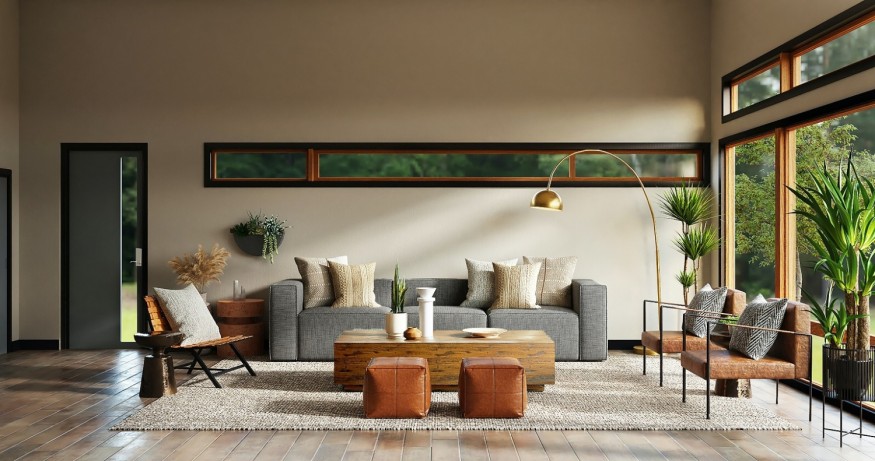Navigating 6 Mega Trends Transforming Home Furniture in 2024

To create spaces that reflect modern lifestyles, interior designers must keep one step ahead of trends in a constantly evolving field. The home furnishings sector is getting ready for big changes in 2024, which a mix of alterations in consumer behavior, environmental consciousness, and technology advancements will fuel. Let's delve into the six megatrends that shape how we furnish and experience our homes in the coming year.
Part 1: Adaptive Living and Multifunctional Furniture
The COVID-19 pandemic has redefined our relationship with our living spaces. Dr. Mahesh M, CEO of Creaticity, identifies the first major trend: Adaptive Living Fuels Demand for Multifunctional Pieces. With homes becoming the focal point for various needs due to remote work and changing dynamics, the demand for versatile furniture is rising. Innovations like Murphy beds, storage beds, foldable workstations, and convertible coffee tables are becoming staples in compact urban homes. This trend aligns with the growing tiny home movement, facilitating the creation of multipurpose rooms that can seamlessly switch functionality.
Part 2: Digitalisation Reshapes Furniture Needs
As smart devices, internet connectivity, and voice assistants become ubiquitous, our homes are evolving into digital ecosystems. In the second trend, Digitalization Influences Furniture Needs and Purchasing; consumers seek furniture seamlessly integrated into this digital landscape. Tech-savvy furniture is rising, from USB charging ports and Bluetooth connectivity to cloud-linked control panels and voice assistant compatibility. The sales process is also shifting online, with immersive presentations and digital tools like 3D renderings enhancing the furniture shopping experience.
Part 3: Sustainability as an Imperative
The third trend, Sustainability Becomes an Imperative, reflects the heightened environmental awareness in today's consumers. Ethical sourcing, minimal carbon footprints, and non-toxic materials are now expected standards. Furniture brands prioritize sustainability through responsible wood sourcing, reduced plastic packaging, renewable energy, and circular business models like rental and resale. The industry aims to minimize waste, decrease greenhouse gas emissions, and promote ethical, eco-friendly practices.
Part 4: Health and Wellness in Furniture Design
The pandemic has amplified the importance of health and wellness in our homes. In the fourth trend, Health and Wellness
Take Center Stage: consumers seek furniture that prioritizes wellness, ergonomics, and functional accessibility. Solutions include orthopedic mattresses, adjustable standing desks, and air-purifying furnishings. Modular furniture accommodates diverse needs, while sustainable materials like antibacterial bamboo align with clean living. Ergonomic chairs and accessories support proper workstation setups, emphasizing furniture's role in nurturing mental and physical well-being.
Part 5: The Rise of Personalisation
The era of mass-produced furniture is making way for personalization. In the fifth trend, Personalization Rules the Roost, consumers seek unique statement pieces that reflect their styles. Brands are responding with modular furnishings, offering customizable options in fabric, finish, and configuration. Custom-built and bespoke services allow tailoring furniture to specific preferences and spatial contexts. Virtual consultations enhance collaboration between customers and designers, shaping furniture decisions based on personal expression and individuality.
Part 6: Premiumisation Attracts Affluent Consumers
The surge in high-net-worth individuals globally opens opportunities for premium and luxury furniture brands. In the sixth trend, Premiumization Attracts Affluent Consumers, brands offer exquisite craftsmanship, artistic design, and opulent materials, symbolizing luxury living. Features like gold foil inlaid marble tables and hand-carved antique reproduction furniture elevate offerings. Multi-sensorial shopping experiences and the concept of furniture as investment assets appeal to discerning upmarket shoppers.
In conclusion, the home furniture industry is changing dynamically, influenced by shifting consumer preferences and priorities. Brands that adapt to key trends offering versatile, digitally integrated, and sustainable furniture designed for wellness and comfort, will dominate the future market. Designing for personalization and quality craftsmanship is crucial for creating compelling spaces that resonate with the evolving identities of consumers. As we enter 2024, the interior design landscape is set to embrace these megatrends, shaping how we live and interact with our surroundings.
From Digital Models to 3D-Printed Homes: Jaspreet Kaur Lall Explains How the Innovation Changes the Construction Industry

Future Belongs to Green Construction: Sampath Kumar Paspunoori Explains One of the Key Trends in the Construction Industry

Kamala Harris' Campaign Ad Uses Iconic Visuals from Carrie Mae Weems to Connect with Voters

Historic Ancient Roman Ruins in Baalbek Remain Strong After Israeli Air Strikes; Locals Seek Cultural Protection

4 Ways to Honor Departed Loved Ones in Your Home Design














